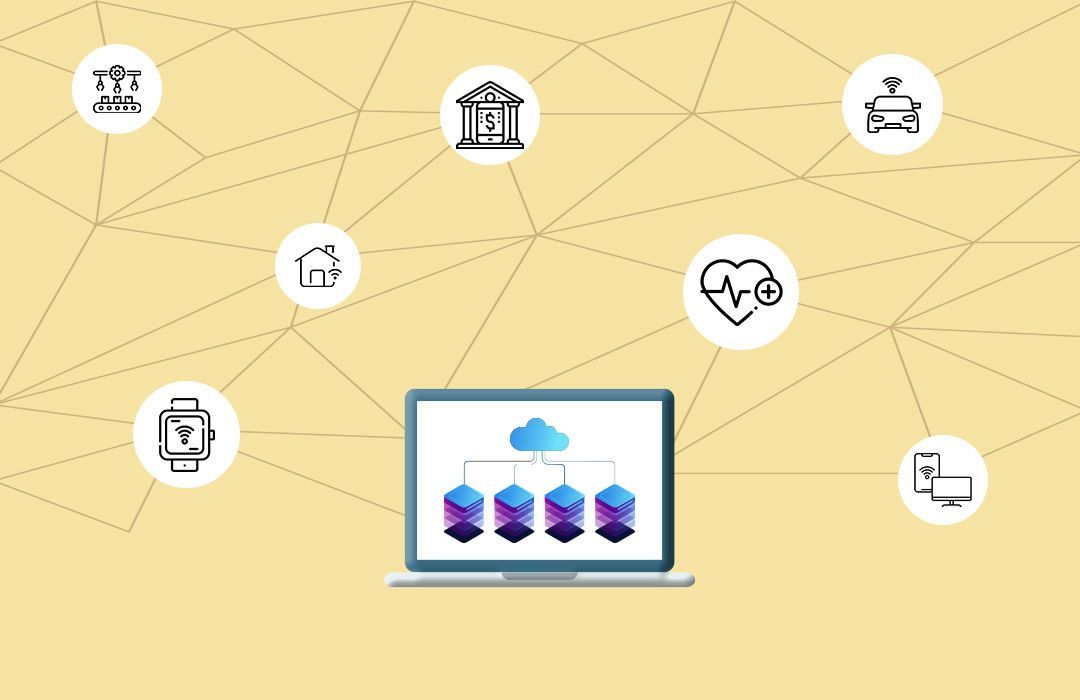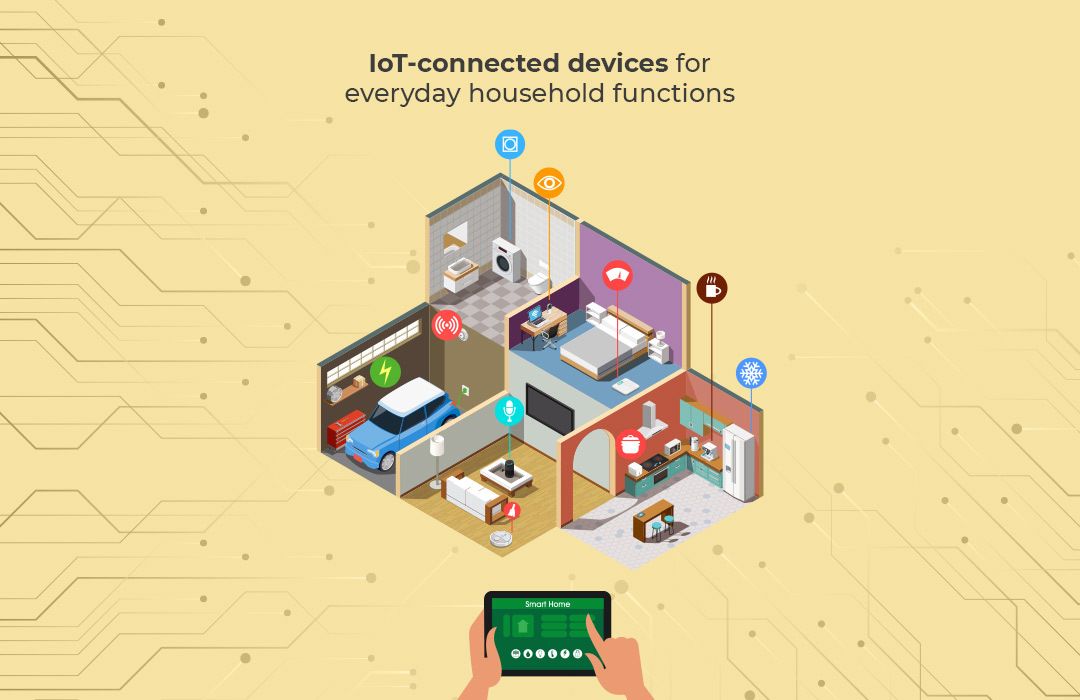How IoT-Connected Devices are transforming every industry vertical

You can find IoT- connected devices almost everywhere. Vehicles for consumer use, asset tracking in enterprises, and environment monitoring are a few of those areas.
As for the impact of these devices, they aren't just mere improvements but are transformative changes.
This blog will explore how IoT-connected devices transform the five most crucial industries like healthcare, fintech, automotive, enterprise, and household functions. You’ll see how these devices make existing processes more efficient and pave the way for new ones.
But what exactly are they?
What are IoT connected devices?
IoT-connected devices are electronic gadgets, machines, devices, or household appliances that can connect wirelessly to a network and have data-transmitting capabilities.
Traditionally these devices were disconnected from physical devices or objects. But now, they can communicate and interact with other devices over the internet.
Here are some good examples of IoT- connected devices for you:
- Up⤴️liance’s IoT cookware firm offers smart cookware for everyday use. It can share real-time data about its usage and report failure immediately. This data helps the company make product development decisions.
- Batteries developed by Exponent energy send millions of data points per hour to Bytebeam’s IoT platform to evaluate their battery conditions. The company leverages these insights in its battery improvement initiatives.
These two examples conclude that IoT-connected devices transmit data. This data is later processed in a cloud platform like Bytebeam or at the device. And the insights gained from this data help in the following:
- identify trends,
- detecting potential issues,
- and optimizing existing processes.
Such optimization brought forward by connected devices is now prevalent in every industry. Take the example of sensors used in retail stores. These sensors can detect the amount of time customers spend in different parts of the room and identify the products they find most engaging in a store.
As a retail store owner, you can use this information to enhance customer experience.
With a fair idea of what devices are and how they can optimize processes, let's dive into how these devices transform different industry verticals.
The transformative impact of IoT connected devices
Consider this industrial scenario: before the introduction of IoT devices into industrial settings, a technician would need to travel to the site of a suspected problem, identify the issue, and then travel to a warehouse to retrieve the necessary parts before returning to diagnose and fix the problem.
However, with the implementation of industrial IoT sensors to monitor assembly lines and manufacturing processes, data can be transmitted to show the health of the parts or notify the technician when a replacement is needed, thus preventing unexpected shutdowns.
In the event of a problem, the IoT platform can identify the issue and notify the technician of the necessary fixes, allowing them to gather the required parts and tools and address the issue simultaneously.
This simple industrial scenario illustrates the many benefits of IoT-connected devices, including cost and time savings by preventing unexpected shutdowns and increased employee productivity by providing technicians with the information they need to identify and address issues quickly.
However, the benefits of IoT connectivity extend beyond industry, with applications in enterprises, households, mobility, healthcare, and fintech that simplify processes and reduce costs.
So let's see the usage of IoT-connected devices for various business purposes across sectors.
IoT connected devices in Healthcare
The transformative impacts of IoT- connected devices in healthcare are most apparent in Home monitoring systems. These systems allowed doctors to track an individual's health remotely. It lowers infection risks, particularly in after-surgery care, and saves the cost and time a patient incurs for trips to the doctor.
Another area where IoT-connected devices will be crucial is remote patient monitoring technology. It enables doctors to manage patients' acute and chronic conditions with the IoT sensors providing an uninterrupted flow of real-time health data. The data may include blood pressure, heart rate, and glucose monitoring. So far, it has been the high costs that have prevented large-scale deployment. But, hospitals and governments are trying to reduce costs and improve outcomes for larger adoption.
As for the widespread Wearable IoT technologies, tech giants such as Apple have developed the Apple Watch Series 8, an enhanced Workout app. It includes fall detection, retrospective ovulation estimates(women's health), crash detection, and ECG. Such devices are becoming so sophisticated that they are saving lives.
IoT connected devices and fintech
ATMs are a well-known example of IoT-connected devices in fintech. They have streamlined cash withdrawals, account balance monitoring, and getting transaction receipts. Also, the Ticketing Kiosks you see in banks have made customer interactions with the right representative easier.
IoT-connected devices are also used in facilities such as night depositories, drive-up systems, and IoT-enabled vaults to enhance system efficiency. However, that’s just the tip of the iceberg regarding the utility of IoT devices in fintech.
These devices can be utilized to provide personalized experiences as well. Financial institutions like Banks can use IoT devices to track customers' spending patterns and help them allocate resources to the right sources.
Providing user-focused, differentiated offerings to customers is another area to reckon with. For instance, IoTs can track the distance you have traveled and your driving behaviors to be used to determine the premiums of Pay As You Drive (PAYD) or Usage–Based Insurance (UBI).
Further, IoT-connected devices could add extra security layers for accessing bank accounts by enabling biometrics (fingerprints). IoT devices can also reduce the increasing number of ATM thefts costing banks and insurance companies. The IoT sensors would track activity around ATMs and send signals to authorities if suspicious patterns are detected.
IoT connected devices for the automotive industry
Cars driving themselves, registering real-time traffic, or running quick on-the-spot system diagnostics are a few indications of a major transformation in the automotive industry, made possible with IoT- connected devices.
The same can be seen in achieving predictive maintenance as well. For instance, fleet management companies embed GPS, RFID, accelerometer, OBD-II, proxy sensors, and gyroscopes in vehicles. As these sensors send data to a coherent system carrying out ongoing diagnostics, it helps prevent sudden vehicle breakdowns. The system can predict the useful life of various vehicle parts, improving operational costs and road safety.
With that being said, more IoT device-enabled transformative impact is yet to come in vehicle manufacturing. For example, data derived through car IoT sensors will give insights to manufacturers into where the recurrent problems occur. This will ensure more precise modification/improvement in various functionalities.
The only limiting thing in this regard is network protection and the need for a wide rollout of 5G technology.
Enterprise and Industries
According to Gartner, IT downtime costs an average of $5600 per minute, which can be reduced with the help of a fleet of IoT-connected devices. As these devices access the health of the equipment by measuring temperature, sounds, power, vibration, and current flow, among other things, predictive maintenance can be scheduled before it can affect production or cause disruption to the workflow ( in case a server goes down).
The same is true for reducing consistent costs an enterprise makes. When integrated into a larger system like an HVAC system, IoT-connected devices can track and control it and detect usage patterns within a building. And the system would be adjusted accordingly to achieve lower time-of-use costs.
As for making existing processes more efficient, a good example can be found in how Ford developed better ergonomic designs for workstations by tracking the bodily movements of workers through IoT-connected devices. The improved workstations saved workers from excessive physical stress and created an optimized work environment.
Another area to consider is visual inspection facilities, widely used in various industries, such as manufacturing, retail, food industry, and medicines. With the help of IoT devices, advanced deep learning technologies identify patterns and take predefined actions like sending notifications or executing other operations. Like picking anomalies(cracks in bottleneck) in an assembly line of sunflower oil production.
All the above-discussed scenarios could be perfected even better with the advancement of IoT technologies.
IoT connected devices for everyday household functions

What's already here
Amazon Echo, Apple's Siri, Google Assistant, and other digital assistants have transformed the smart home industry in various ways. These IoT-connected devices have made it possible to manage appliances, lights, and home security systems remotely. However, there is a long way to go when making household chores less time-consuming and effortless.
Laundry:
Currently, the laundry management task takes a massive amount of an individual’s time and effort. However, it’ll no longer be the case as a single smartphone app will soon track and control various washing parameters like the number of washing cycles completed, machine speed, washing schedules, and laundry allocation.
Also, automatic washing can be executed depending on when certain clothes are worn and need cleaning. These machines will sense the dart level in fabric types ( school uniform, workwear, denim, linen clothes) and speed up drying and washing.
House cleaners:
Though robotic home cleaners can carry out cleaning independently, the future will see autonomous robotic home cleaners using specialized mapping algorithms. They'll cleanse walls, cubby holes, and narrow crevices and suck dust with the help of integrated AI assistance and voice commands. Going one step further, these devices will regulate their power consumption and require less energy to run as only areas requiring cleaning will be cleaned.
Here's what limits the full utilization of IoT connected devices across industries
Cyber Security
In March of 2021, a cloud-based video surveillance service named Verkada was hacked. Hackers could access over 150,000 cameras using legitimate admin account credentials of the devices found on the internet. They got live feeds from hospitals, factories, prisons, and other sites. The attack also revealed the existence of 'Super Admin' privileges given to 100 company employees, using which they could see customers' camera footage anytime. However, these security threats are preventable to a large extent if IoT device users.
- refrain from using the default passwords,
- encrypt communications,
- use multiple networks to isolate devices
- use VPN
Data governance
IoT device manufacturing companies can find themselves in jeopardy when they don’t first understand the problem they’re trying to solve with the collected data. Things get complicated further when they constantly try to keep up with the new data influx from rapid IoT device growth.
A clearly defined data privacy policy should outline how the collected data would be used. It should also elaborate on the scope of processing the data.
Scaling/deployment challenge
Inmarsat's ( International Mobile Satelite Organization) research suggests that in-house skills are the main barriers to deploying new IoT projects. The next major obstacle is the need for reliable connectivity, as most valuable data often comes from IoT devices placed in the inaccessible places. However, the research found that organizations with formal IoT strategies cope with these problems way better than those without.
IoT companies take a lot of time to come live
IoT companies take around 18 months to go live with their backend on average. Such a long time makes companies feel that their investment needs are exceeding their expectations. But solutions like BYTEBEAM are changing it by ensuring the Time-to-Market is at least three weeks.
Chip Shortage
Forrester Research predicted a limited growth of IoT because of the ongoing global chip shortage. This shortage may get completely resolved in the middle of 2023.
Final Thoughts
IoT-connected devices are bringing transformative changes in every industry. And their deployment is also speeding up. But the companies developing various IoT-connected devices are encountering several obstacles regarding time to come live, scaling to millions of devices, and in-house skill sets to handle data engineering, among others.
To address some of these problems, Bytebeam has designed a much-needed solution. It ensures that IoT device manufacturers can go live with their backend in three weeks, scale to millions of devices easily, and act on customer feedback with real-time analytics.
